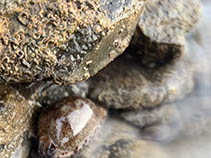Mauritia arabica (Linnaeus, 1758)
Arabian cowrie
Classification / Names Common names | Synonyms | CoL | ITIS | WoRMS
Gastropoda | Littorinimorpha | Cypraeidae
Environment: milieu / climate zone / depth range / distribution range Ecology
Benthic; depth range ? - 10 m (Ref. 126058). Tropical
Distribution Countries | FAO areas | Ecosystems | Occurrences | Introductions
Indo-Pacific.
Length at first maturity / Size / Weight / Age
Maturity: Lm ? range ? - ? cm Max length : 10.5 cm SHL male/unsexed; (Ref. 349); common length : 8.0 cm SHL male/unsexed; (Ref. 349)
Short description Morphology
Shell is smooth and shiny, with an elliptical to egg-like shape. Brown, with distinctive variable fine dark brown line patterns on the dorsal surface and black spots on the two sides. Ventral surface appears cream to gray. Aperture is long and narrow, without an operculum. Both upper and lower lips are lined with small teeth.
Collected for food by coastal populations in many areas. Shell used in shellcraft or sold for collections (Ref. 349). Found in coral reef and rocky habitats, common in shallow water and tide pools (Ref. 128042), under slabs and stones and in caverns of the outer edge of coral reefs. Inhabits well-aerated waters. Mainly nocturnal (Ref. 349). Members of the family Cypraeidae are primarily carnivores (Ref. 67623). Reported from Hong Kong to be found on the ceilings and walls of submarine caves (Ref. 126058).
Life cycle and mating behavior Maturity | Reproduction | Spawning | Eggs | Fecundity | Larvae
Members of the order Neotaenioglossa are mostly gonochoric and broadcast spawners. Life cycle: Embryos develop into planktonic trocophore larvae and later into juvenile veligers before becoming fully grown adults.
Main reference
References | Coordinator | Collaborators
Poutiers, J.M. 1998. (Ref. 349)
IUCN Red List Status (Ref. 130435)
CITES status (Ref. 108899)
Not Evaluated
CMS (Ref. 116361)
Not Evaluated
Threat to humans
Harmless
Human uses
Fisheries: commercial
| FishSource |
Tools
More information
Internet sources
BHL | BOLD Systems | CISTI | DiscoverLife | FAO(Publication : search) | Fishipedia | GenBank (genome, nucleotide) | GloBI | Gomexsi | Google Books | Google Scholar | Google | PubMed | Tree of Life | Wikipedia (Go, Search) | Zoological Record
Estimates based on models
Preferred temperature
(Ref. 115969): 25.1 - 29.3, mean 28.4 (based on 2882 cells).
Price category
(Ref. 80766):
Unknown.



